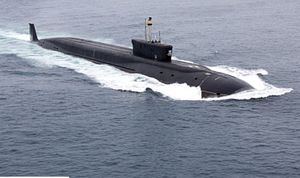Russia has floated out the first advanced variant of the nuclear-powered ballistic missile submarine (SSBN) Project 955A Borei II-class (“North Wind”), or Dolgorukiy-class.
The Borei II-class (also designated Borei-A) boomer Knyaz Vladimir (Prince Vladimir) was launched during a float out ceremony at the Sevmash Shipyards in Severodvinsk in northern Russia on November 17. The ceremony was attended by the commander-in-chief of the Russian Navy, Admiral Vladimir Korolyov, and other senior naval officers and high ranking defense industry officials.
The new boomer was laid down in July 2012 and is expected to be delivered to the Russian Navy next year. Once commissioned, it will be Russia’s most advanced SSBN ever to conduct nuclear deterrence patrols. Next to improved maneuverability and purportedly improved stealth capabilities, the Borei II-class SSBN will carry a heavier nuclear payload (See: “Russia Will Start Constructing New Ballistic Missile Submarine in December”):
In comparison to the Borei-class, Borei II[A]-class submarines are fitted with four additional missile tubes, boast smaller hulls and cons, and feature improved acoustics and lower sound levels, next to a number of other technical improvements.
Both variants of Borei-class subs will be armed with Bulava (RSM-56) intercontinental ballistic missiles (ICBMs). The Borei-class will be capable of carrying up to 16 Bulava ICBMs, whereas the improved Borei II-class can carry up to 20 ballistic missiles.
The improved variant of the Borei-class will be capable of launching 96-200 hypersonic, independently maneuverable warheads, yielding 100-150 kilotons apiece.
Russia plans to build a total of eight Borei-class SSBNs – three Borei-class and five improved Borei II-class boats – by 2o25. The date was recently confirmed by Admiral Korolyov, although delays are to be expected. For example, the construction of the Knyaz Vladimir began with a two-year delay due to contract disputes between the Russian Ministry of Defense and Sevmash Shipyards.
“Three Borei-class SSBNs have been commissioned to date with one submarine, the Yuri Dolgoruky, serving with the Northern Fleet and the remaining two – Alexander Nevsky and Vladimir Monomakh — deployed with Russia’s increasingly more active Pacific Fleet,” I reported in June.
In his remarks on November 17, Korolyov also mentioned Russia’s intention develop a more advanced variant of the Borei-class in addition to a separate class of next-generation nuclear powered submarines.
“The development and the construction of the series of Project Borei-A strategic missile-carrying underwater cruisers and the eventual development of Project Borei-B submarines with the subsequent construction of fifth-generation nuclear-powered subs are prompted by the provisions of Russia’s naval doctrine and aimed at fulfilling the task of maintaining the armament and equipment of the groupings of strategic submarines in the Pacific and Northern Fleets at a high level,” the admiral said, according to TASS news agency.
Work on the Borei B-class has allegedly already started. The new class of fifth-generation nuclear-powered subs (dubbed Husky-class) will reportedly come in three variants (SSN, SSG, and SSBN) and is expected to replace Project 971 Akula-class SSNs beginning in the 2030s. As I reported in July, the Rubin Central Design Bureau, which also designed and developed the Borei-class, has finished preliminary design work of new conventional fifth-generation submarine code named Project Kalina. The new sub will be based on the Project 677 Lada-class diesel-electric attack submarine.
































